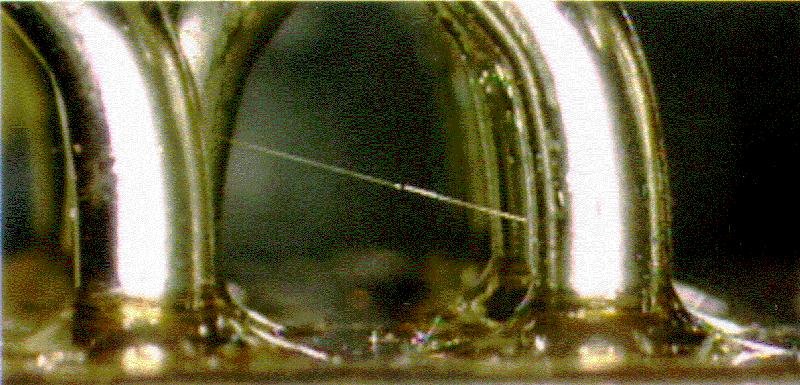|
About NPSL
Prohibited Materials
Parts Selection Table of Contents
Other Space Agency
EEE Parts Selection Listings
European Space Agency (ESA)
Japan Aerospace Exploration Agency
(JAXA)
|
Pure Tin Plating Prohibition
Policy:
Pure tin plating is prohibited as a final finish on EEE parts and associated
hardware
Reference:
Rationale:
Pure tin finishes
are susceptible to the spontaneous growth of electrically conductive single
crystal structures known as tin whiskers. Over time these whiskers
may grow to be several millimeters (mm) long. Tin whiskers are capable
of causing electrical failures ranging from parametric deviations to sustained
plasma arcing that can result in catastrophic short circuits.

Several instances
have been reported where tin whiskers have caused system failures in both
earth and space-based applications including at least 3 separate events where
a tin whisker induced short circuit resulted in complete failure of a
commercial satellite.
The general risks
fall into four categories:
- Stable short
circuits in low voltage, high impedance circuits. In such circuits
there may be insufficient current available to fuse the whisker open
and a stable short circuit results. Depending on the diameter and length
of the whisker, it can take more than 50 milliamps (mA) to fuse one
open. More typical is ~10mA
- Transient short
circuits. At atmospheric pressure, if the available current exceeds
the fusing current of the whisker, the circuit may only experience a
transient glitch as the whisker fuses open.
- Metal Vapor
Arcing. If
a tin whisker initiates a short in an application environment
possessing high levels of current and voltage, then a VERY DESTRUCTIVE
phenomenon known as a Metal Vapor Arc can occur.
The ambient pressure, temperature and the presence of arc suppressing
materials also affect metal vapor arc formation. In a metal vapor arc,
the solid metal whisker is vaporized into a plasma of HIGHLY
CONDUCTIVE metal ions (more conductive than the solid whisker itself).
This plasma can form an ARC capable of carrying HUNDREDS OF
AMPERES. Such arcs can be sustained for long duration (several
seconds) until interrupted by circuit protection devices (e.g., fuses,
circuit breakers) or until other arc extinguishing processes occur.
This kind of arcing is happening in the metal vapor. When an arc
quenching agent (e.g., air) is present, more power must be installed
into the event to replace power lost to the non-interesting processes
happening in the quenching agent. Therefore, as air pressure is
reduced, less power is required to initiate and sustain a
whisker-induced metal vapor arc. For example, past experiments**
have demonstrated that at atmospheric pressures of about 150 torr, a
tin whisker could initiate a sustained metal vapor arc where the
supply voltage was approximately 13 Volts (or greater) and supply
current was 15 Amps (or greater). Tin (or other materials) from
the adjacent surfaces can help to sustain the arc until the available
material is consumed or the supply current is interrupted. Metal
vapor arcs in vacuum are reported to have occurred on at least three
commercial satellites resulting in blown fuses that rendered the
spacecraft non-operational.
** J.H. Richardson, and
B.R. Lasley, "Tin Whisker Initiated Vacuum Metal Arcing in
Spacecraft Electronics," 1992 Government Microcircuit
Applications Conference, Vol. XVIII, pp. 119 - 122, November 10 - 12,
1992.Basic Info on Tin Whiskers
- Debris/Contamination.Whiskers
or parts of whiskers may break loose and bridge isolated conductors
or interfere with optical surfaces
Recommendations:
At this time, the
only sure way of avoiding tin whiskers is not to use parts plated with
pure tin. Despite procurement specification requirements that prohibit
pure tin, errors sometimes occur resulting in pure tin plated components
being delivered. Therefore, users are advised to independently test and
analyze the plating composition of the products received as a verification
that pure tin plating is not in use. Simple visual inspection is generally
not sufficient because pure tin plating may appear similar to other plated
finishes such as tin/lead or nickel.
Utilization of procurement
specifications that have clear restrictions against the use of pure tin
plating is still recommended. Most, but not all, of the commonly used
military specifications currently have prohibitions against pure tin plating.
Studies have shown that alloying tin with a second metal can reduce the propensity
for whisker growth. Generally speaking, alloys of tin and lead (Pb) are acceptable where the alloy
contains a minimum of 3% Pb by weight. The effects on tin whisker
formation of alloying materials other than Pb are not well understood.
In the event pure
tin plated parts cannot be avoided, there are some additional processing
techniques that may be used to reduce but not eliminate the risks
associated with tin whiskers. The effectiveness of these approaches is
variable and most require further evaluation to determine their suitability
for long duration missions. Examples of these approaches include:
- Solder dipping
pure tin plated terminations and leads using a leaded solder. The effectiveness
of this approach at covering all pure tin plated surfaces can be variable.
- Application of
conformal coat material to pure tin plated surfaces. Conformal coat
appears to reduce the growth rate of tin whiskers, but whiskers are
still capable of growing through some conformal coat materials such
as polyurethanes.
- For some device
types manufacturers may be willing to replate surfaces using finishes
such as tin/lead or nickel which are substantially less prone to whisker
formation.
|


